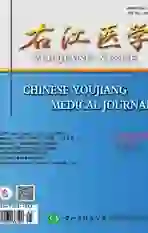TERT启动子突变与尿路上皮肿瘤的研究进展
2019-07-01曾丽霞马韵
曾丽霞 马韵
【摘要】 端粒酶可赋予真核细胞无限增殖的能力,而端粒酶逆转录酶(TERT)是端粒酶活化的重要催化亚单位,其启动子的突变与多种肿瘤包括尿路上皮癌密切相关,提示其是肿瘤形成过程中的始动因素。该文将就近年来TERT启动子突变与尿路上皮肿瘤的发生、相关作用机制及潜在的临床应用价值等方面的研究展开综述。
【关键词】 TERT;启动子突变;尿路上皮癌
中图分类号:R737.15 文献标志码:A DOI:10.3969/j.issn.1003-1383.2019.05.001
【Abstract】 Telomerase activity imparts eukaryotic cells with unlimited proliferation capacity.Telomerase reverse transcriptase(TERT) is the key catalytic subunit of telomerase activation,the mutation of its promoter is closely related to a variety of tumors,including urothelial cancer(UC),which suggests that TERT is the initiating factor in the process of tumor formation.This article reviews recent researches on the relationship between TERT promoter mutation and the occurrence of urothelial cancer,its related mechanisms of action and potential clinical application,etc.
【Key words】 TERT;promoter mutation;urothelial cancer
人端粒存在于细胞染色体的末端,起到维持染色体的完整性及调控细胞衰老的作用[1];端粒酶通过延长端粒重复序列来维持染色体的稳定性。肿瘤细胞可以通过上调端粒酶的活性来维持端粒的长度,从而实现肿瘤细胞的永生化。端粒酶主要由三部分组成:RNA成分(TR)、端粒酶相关蛋白及主要的催化亚单位和活性成分端粒酶逆转录酶(telomerase reverse transcriptase,TERT)。TERT是端粒酶的活性組分及限速步骤[1]。人TERT基因位于染色体的5p15.33上,其启动子区是调控端粒酶活性表达的重要结构。该基因的核心启动子区包含260个碱基,启动子富含GC序列,缺少TATA盒和CAAT盒,包含5个以上的SP1结合位点,2个E-boxes盒及1个转录起始点,可结合多种转录因子,比如:c-Myc、SP1、STAT3、p53等调控TERT的转录[2~4]。一些原癌基因的激活和抑癌基因的沉默被发现可以通过诱导TERT的转录来实现肿瘤的永生化[5]。TERT启动子区位于转录起始点附近的富于GC区,可以通过甲基化等途径来调控肿瘤的表观遗传学改变[6]。近来发现在多种肿瘤中TERT启动子突变在激活端粒酶活性过程中发挥重要作用,该启动子突变后可上调TERT的表达,与某些肿瘤的不良预后密切相关[7];但也有一些研究表明TERT启动子突变与预后无关,具体机制有待进一步研究。现就近年来TERT启动子突变与尿路上皮肿瘤的发生、相关作用机制及潜在的临床应用价值等方面的研究展开综述。
1 肿瘤组织中的TERT启动子突变
2013年在对黑色素瘤全基因组的测序研究中首次发现TERT启动子区核心区域序列中存在两个高频突变位点,即1295 228 C>T和1295 250 C>T[8~9]。随后对多种肿瘤的检测发现TERT启动子区突变可较高频率存在于肉瘤、膀胱癌、胶质瘤、甲状腺癌及肝癌等多种肿瘤中,并且发现这种高突变组的肿瘤均来源于自我更新率相对较低的组织[10~13]。TERT在正常体细胞中表达受到抑制,在肿瘤细胞中其激活机制不甚清楚。在一些肿瘤中发现了有TERT启动子区突变的组织,其基因表达量明显高于未突变的野生型[11~14]。研究表明TERT启动子突变只有形成特异性的Ets/TCF转录因子结合位点并且募集转录因子后才能够对TERT的表达有影响;部分Ets/TCF转录因子是MAPK信号通路的下游靶点[15~16]。通过对国内13种不同类型的肿瘤、799例组织来源于肿瘤患者的研究显示[17],TERT启动子突变在胶质母细胞瘤、尿路上皮癌、少突胶质细胞瘤、髓母细胞瘤及肝细胞癌中的突变率分别为83.9%、64.5%、70.0%、33.3%及31.4%,C228T与C250T是最常见的突变位点;TERT启动子的高频突变提示其是肿瘤形成过程中的始动因素。
在成人胶质肿瘤中TERT启动子突变与TERT mRNA的高表达及端粒酶的活性相关,且可导致EGFR扩增和IDH1突变。在甲状腺癌中可诱导RAS-BRAF信号通路的激活;TERT启动子的突变可诱导上皮细胞向间质细胞转化,促使肿瘤远处转移和侵袭,可能与肿瘤预后相关[12]。除了维持端粒长度,TERT还有其他不依赖于端粒长度非经典的可影响某些生物学过程的功能,比如在神经胶质瘤中TERT调节Wnt/β-Catenin信号通路促使细胞去分化,调控NF-κB的表达[18]和涉及RNA聚合酶1的DNA转录,导致细胞持续扩增[19]。端粒可以感知细胞的应激状态,诱导细胞衰老以防止肿瘤的发生。其中一种重要的机制是端粒能够形成G4(G-quadruplex)的复制叉4链结构,这种结构在复制和转录过程中优先形成。一旦这种G4结构不能被解开,复制就会停滞,削弱细胞的增殖;而端粒酶参与G4的解除。原癌基因诱导的衰老(oncogene-induced senescence,OIS)[20]和非整倍体诱导的衰老(aneuploidy-induced senescence,AIS)与端粒长度无关,可以被活化的端粒酶所抑制,这种抑制作用通常会使端粒酶阳性的细胞获得肿瘤始动性的突变[21]。端粒酶是如何抑制与端粒长度无关的端粒对细胞的保护功能目前尚不清楚。
2 尿路上皮肿瘤中TERT启动子突变与癌的发生
尿路上皮肿瘤(Urothelial Carcinoma,UC)是泌尿系統最常见的恶性肿瘤,分为肾盂癌(Renal Pelvis Carcinoma,RPC)、输尿管癌(Ureteral Carcinoma,UC)和膀胱癌(Urothelial Carcinoma of the Bladder,UCB),其中前两者合称为上尿路尿路上皮癌(Upper Tract Urothelial Carcinoma,UTUC)。膀胱尿路上皮癌是泌尿外科最常见的发生于膀胱的实体性肿瘤,占膀胱癌的90%以上。UTUC相对少见,且缺乏早期的临床症状,被发现时病变已为浸润性。研究表明起源于尿路上皮的癌是通过TERT基因的异常激活获得永生化的[22]。在尿路上皮肿瘤中TERT启动子突变率超过其他任何突变,并广泛存在于各种病理组织学分级及临床分期中,提示TERT启动子突变是肿瘤发生的早期事件[23]。
膀胱癌形成过程至少有2种不同的分子途径。约75%为非肌层浸润性膀胱癌(Non-muscle Invasive Bladder Cancer,NMIBC),有特征性FGFR3和HRAS基因突变,有极高的复发率,仅少数进展为肌层浸润性癌。肌层浸润性膀胱癌(Muscle Invasive Bladder Cancer,MIBC)有特征性p53及RB基因的缺失。膀胱癌中TERT以C228T和C250T的突变最常见[24]。Hosen等[13]对327例膀胱尿路上皮癌的研究发现,TERT启动子突变比FGFR3常见,且两者呈相关性。
对比尿路上皮癌和正常尿路上皮细胞,研究人员发现UCB样本中的基底细胞(CD44和CK5为+,CK20为-)中存在TERT启动子的突变,且以C228T为主;而正常尿路上皮的基底细胞无该类突变。将有C228T突变的基因恢复到野生型序列,小鼠异种移植实验中的膀胱癌细胞的成瘤能力被消除[25]。这表明TERT启动子突变是人类尿路上皮细胞恶性转化的关键事件,优先发生在缺乏端粒酶活性的增殖活性低的细胞恶性转化过程中。在2015年发表的一项研究中,研究人员在人类胚胎干细胞(human embryonic stem cells,hESCs)中引入了常见的TERT启动子突变,并证明这些突变可激活TERT启动子及端粒酶的活性,阻止了端粒缩短,从而使细胞具有无限增殖的能力[26]。Borah等[27]对23种不同的人尿路上皮癌细胞系的研究表明,TERT启动子突变与其mRNA、蛋白、酶活性的表达及端粒的长度相关。
TERT启动子突变在尿路上皮肿瘤的发生中具有组织特异性,原发性膀胱癌中,55%~83%的样本至少存在一种TERT启动子的热点突变;而在9种良性增殖性尿路上皮病变中只有野生型的TERT启动子序列[23]。通过对11例膀胱小细胞的研究发现,TERT启动子的突变率为100%,突变位点均为C228T,提示其来源于尿路上皮肿瘤细胞,而其他组织来源的小细胞癌均未检测出TERT突变[28]。在15例膀胱鳞状细胞癌中发现,TERT启动子突变率为80%,其中83%为-124bp G>A,17%为-146bp G>A[29]。在膀胱腺癌中,TERT启动子突变仅限于非肠型腺癌[30]。
3 TERT启动子突变的预后价值
膀胱癌中TERT启动子区突变的频率最高;同时存在此类突变的膀胱癌患者生存时间明显短于未突变患者,且易于复发[31]。国内吴松等人[32]通过对302例泌尿生殖系统恶性肿瘤的筛查及分析发现,TERT启动子突变在各种类型的肿瘤中差异极大,突变率为0~63.7%;这种突变上调了TERT的表达,促进了肿瘤细胞的侵袭性;并与肿瘤的TP53/RB1信号通路有关。王坤等人[33~34]研究提示尿路上皮癌组织及尿液中存在TERT启动子突变,上尿路肾盂及下尿路尿路上皮癌的突变率明显高于输尿管者,并与预后相关。有研究人员评估了两个UCB的独立化疗组的TERT启动子突变和TERT mRNA表达水平与患者生存的相关性,发现TERT mRNA的量与总生存率密切相关[27]。而另一组研究分析了230例NMIBC和25例MIBC的尿液样本,发现TERT启动子突变与NMIBC向MIBC演进有显著的相关性[35]。同样值得关注的是TERT启动子突变与UTUC的远处转移有关[34]。但欧洲的一些学者研究发现[36],TERT启动子的突变与其mRNA表达、临床病理学参数及膀胱癌患者的预后无关,与存在FGFR3突变相关。TERT启动子突变在不同人群及不同组织学类型的尿路上皮肿瘤中的预后作用及相关作用机制有待深入研究。
4 TERT启动子突变的诊断作用及治疗应用前景
关于TERT启动子突变可能有助于尿路上皮肿瘤病理学诊断及鉴别诊断的报道极少。有研究报道[37],72%的伴有腺样分化的尿路上皮癌的TERT启动子有突变;TERT启动子突变与尿路上皮癌相关,而与膀胱其他类型的腺样病变无关。结合形态特征、免疫表型及临床信息,TERT启动子突变可以较好地用于伴有腺样分化的尿路上皮癌和其他类型膀胱腺样病变的鉴别;同时也提示无TERT启动子突变的原发性膀胱腺癌是一组在起源上与尿路上皮癌发生不同的疾病。Cheng等[38]检测了26例内翻性乳头状瘤,26例尿路上皮癌(内翻型),普通型的尿路上皮癌(包括36例非浸润性和35例浸润性尿路上皮癌)及25例腺性膀胱炎病变组织样本中TERT启动子的突变状况,发现内翻性乳头状瘤、内翻型的尿路上皮癌、普通型的尿路上皮癌及腺性膀胱炎中TERT启动子突变率分别为15%(4/26)、58%(15/26)、63%(45/71)及0%(0/25);其中以C228T突变为主,高达97%;在膀胱尿路上皮恶性肿瘤中,TERT启动子突变与性别、组织学分级及病理分期无关,同时也提示小部分膀胱的内翻性乳头状瘤可能会经历与尿路上皮癌发生相似的路径;对TERT启动子突变的筛查有助于膀胱癌更客观的诊断。Zhong等[39]发现,膀胱巢状变异型尿路上皮癌存在高频率C228T的突变,与之相似的良性病变中无TERT启动子突变,提示其可成为这两种良恶性疾病鉴别的重要依据。
無创性的尿液检测是目前用于非浸润性UCB的复发及高危人群UCB筛查的常规手段,但缺乏有效的诊断分子标志物。尿中检测到TERT启动子突变往往提示有尿路上皮恶性肿瘤可能。一项回顾性研究表明,尿中TERT启动子突变是检测疾病复发的合适指标[27]。然而关于该突变临床检测的应用价值还有待于大量前瞻性研究的进行。
大部分人类恶性肿瘤中有活性端粒酶,其是肿瘤进展所需要的重要因素。随着种系变异的TERT启动子突变和体细胞突变机制的进一步阐明,势必将有助于推动端粒酶的靶向治疗。针对端粒酶本身的抑制剂(如Imetelstat),由于有严重的造血功能抑制作用,目前仅限于骨髓增殖性疾病而非实体瘤的治疗[40]。之后的研究显示,端粒酶底物、端粒保护蛋白复合物及端粒酶非经典的端粒外功能正成为有效治疗靶点筛选的候选因素[41]。
综上所述,TERT启动子突变是尿路上皮癌中最常见的突变形式,是肿瘤发生的早期事件,目前的研究结果显示其预后价值方面仍存在一些争议;对不同类型尿路上皮肿瘤诊断价值的评估及其是否可以用作预测对端粒酶抑制剂试验患者有效反应的标志物皆有待多中心、大样本和进一步深入研究。
参 考 文 献
[1] de Lange T.How telomeres solve the end-protection problem[J].Science,2009,326(5955):948-952.
[2] Xu D,Dwyer J,Li H,et al.Ets2 maintains hTERT gene expression and breast cancer cell proliferation by interacting with c-Myc[J].J Biol Chem,2008,283(35):23567-23580.
[3] Zhao Y,Wang S,Popova EY,et al.Rearrangement of upstream sequences of the hTERT gene during cellular immortalization[J].Genes Chromosomes Cancer,2009,48(11):963-974.
[4] Smith KS,Yadav VK,Pedersen BS,et al.Signatures of accelerated somatic evolution in gene promoters in multiple cancer types[J].Nucleic Acids Res,2015,43(11):5307-5317.
[5] Goueli BS,Janknecht R.Upregulation of the Catalytic Telomerase Subunit by the Transcription Factor ER81 and Oncogenic HER2/Neu,Ras,or Raf[J].Mol Cell Biol,2004,24(1):25-35.
[6] Zhu J,Zhao Y,Wang S.Chromatin and epigenetic regulation of the telomerase reverse transcriptase gene[J].Protein Cell,2010,1(1):22-32.
[7] Vogelstein B,Papadopoulos N,Velculescu VE,et al.Cancer genome landscapes[J].Science,2013,339(6127):1546-1558.
[8] Huang FW,Hodis E,Xu MJ,et al.Highly recurrent TERT promoter mutations in human melanoma[J].Science,2013,339(6122):957-959.
[9] Horn S,Figl A,Rachakonda PS,et al.TERT promoter mutations in familial and sporadic melanoma[J].Science,2013,339(6122):959-961.
[10] Killela PJ,Reitman ZJ,Jiao Y,et al.TERT promoter mutations occur frequently in gliomas and a subset of tumors derived from cells with low rates of self-renewal[J].Proc Natl Acad Sci U S A,2013,110(15):6021-6026.
[11] Liu X,Bishop J,Shan Y,et al.Highly prevalent TERT promoter mutations in aggressive thyroid cancers[J].Endocr Relat Cancer,2013,20(4):603-610.
[12] Landa I,Ganly I,Chan TA,et al.Frequent somatic TERT promoter mutations in thyroid cancer: higher prevalence in advanced forms of the disease[J].J Clin Endocrinol Metab,2013,98(9):E1562-1566.
[13] Hosen I,Rachakonda PS,Heidenreich B,et al.Mutations in TERT promoter and FGFR3 and telomere length in bladder cancer[J].Int J Cancer,2015,137(7):1621-1629.
[14] Tallet A,Nault JC,Renier A,et al.Overexpression and promoter mutation of the TERT gene in malignant pleural mesothelioma[J].Oncogene,2014,33(28):3748-3752.
[15] Heidenreich B,Rachakonda PS,Hemminki K,et al.TERT promoter mutations in cancer development[J].Curr Opin Genet Dev,2014,24:30-37.
[16] Nencha U,Rahimian A,Giry M,et al.TERT promoter mutations and rs2853669 polymorphism:prognostic impact and interactions with common alterations in glioblastomas[J].J Neurooncol,2016,126(3):441-446.
[17] Huang DS,Wang Z,He XJ,et al.Recurrent TERT promoter mutations identified in a large-scale study of multiple tumour types are associated with increased TERT expression and telomerase activation[J].Eur J Cancer,2015,51(8):969-976.
[18] Ghosh A,Saginc G,Leow SC,et al.Telomerase directly regulates NF-kappaB-dependent transcription[J].Nat Cell Biol,2012,14(12):1270-1281.
[19] Xie L,Gazin C,Park SM,et al.A synthetic interaction screen identifies factors selectively required for proliferation and TERT transcription in p53-deficient human cancer cells[J].PLoS Genet,2012,8(12):e1003151.
[20] Suram A,Kaplunov J,Patel PL,et al.Oncogene-induced telomere dysfunction enforces cellular senescence in human cancer precursor lesions[J].EMBO J,2012,31(13):2839-2851.
[21] Hewitt G,Jurk D,Marques FD,et al.Telomeres are favoured targets of a persistent DNA damage response in ageing and stress-induced senescence[J].Nat Commun,2012,3:708.
[22] Chapman EJ,Kelly G,Knowles MA.Genes involved in differentiation,stem cell renewal,and tumorigenesis are modulated in telomerase-immortalized human urothelial cells[J].Mol Cancer Res,2008,6(7):1154-1168.
[23] Kurtis B,Zhuge J,Ojaimi C,et al.Recurrent TERT promoter mutations in urothelial carcinoma and potential clinical applications[J].Ann Diagn Pathol,2016,21:7-11.
[24] Theodorescu D,Cech TR.Telomerase in bladder cancer:back to a better future?[J].Eur Urol,2014,65(2):370-371.
[25] Li C,Wu S,Wang H,et al.The C228T mutation of TERT promoter frequently occurs in bladder cancer stem cells and contributes to tumorigenesis of bladder cancer[J].Oncotarget,2015,6(23):19542-19551.
[26] Chiba K,Johnson JZ,Vogan JM,et al.Cancer-associated TERT promoter mutations abrogate telomerase silencing[J].Elife,2015,4.
[27] Borah S,Xi L,Zaug AJ,et al.Cancer.TERT promoter mutations and telomerase reactivation in urothelial cancer[J].Science,2015,347(6225):1006-1010.
[28] Zheng X,Zhuge J,Bezerra SM,et al.High frequency of TERT promoter mutation in small cell carcinoma of bladder,but not in small cell carcinoma of other origins[J].J Hematol Oncol,2014,7:47.
[29] Cowan M,Springer S,Nguyen D,et al.High prevalence of TERT promoter mutations in primary squamous cell carcinoma of the urinary bladder[J].Mod Pathol,2016,29(5):511-515.
[30] Cowan ML,Springer S,Nguyen D,et al.Detection of TERT promoter mutations in primary adenocarcinoma of the urinary bladder[J].Hum Pathol,2016,53:8-13.
[31] Rachakonda PS,Hosen I,de Verdier PJ,et al.TERT promoter mutations in bladder cancer affect patient survival and disease recurrence through modification by a common polymorphism[J].Proc Natl Acad Sci U S A,2013,110(43):17426-17431.
[32] Wu S,Huang P,Li C,et al.Telomerase reverse transcriptase gene promoter mutations help discern the origin of urogenital tumors: a genomic and molecular study[J].Eur Urol,2014,65(2):274-277.
[33] Wang K,Liu T,Liu C,et al.TERT promoter mutations and TERT mRNA but not FGFR3 mutations are urinary biomarkers in Han Chinese patients with urothelial bladder cancer[J].Oncologist,2015,20(3):263-269.
[34] Wang K,Liu T,Liu L,et al.TERT promoter mutations in renal cell carcinomas and upper tract urothelial carcinomas[J].Oncotarget,2014,5(7):1829-1836.
[35] Critelli R,Fasanelli F,Oderda M,et al.Detection of multiple mutations in urinary exfoliated cells from male bladder cancer patients at diagnosis and during follow-up[J].Oncotarget,2016,7(41):67435-67448.
[36] Allory Y,Beukers W,Sagrera A,et al.Telomerase reverse transcriptase promoter mutations in bladder cancer: high frequency across stages,detection in urine,and lack of association with outcome[J].Eur Urol,2014,65(2):360-366.
[37] Vail E,Zheng X,Zhou M,et al.Telomerase reverse transcriptase promoter mutations in glandular lesions of the urinary bladder[J].Ann Diagn Pathol,2015,19(5):301-305.
[38] Cheng L,Davidson DD,Wang M,et al.Telomerase reverse transcriptase(TERT) promoter mutation analysis of benign,malignant and reactive urothelial lesions reveals a subpopulation of inverted papilloma with immortalizing genetic change[J].Histopathology,2016,69(1):107-113.
[39] Zhong M,Tian W,Zhuge J,et al.Distinguishing nested variants of urothelial carcinoma from benign mimickers by TERT promoter mutation[J].Am J Surg Pathol,2015,39(1):127-131.
[40] Baerlocher GM,Oppliger Leibundgut E,Ottmann OG,et al.Telomerase Inhibitor Imetelstat in Patients with Essential Thrombocythemia[J].N Engl J Med,2015,373(10):920-928.
[41] Günes C,Wezel F,Southgate J,et al.Implications of TERT promoter mutations and telomerase activity in urothelial carcinogenesis[J].Nat Rev Urol,2018,15(6):386-393.
